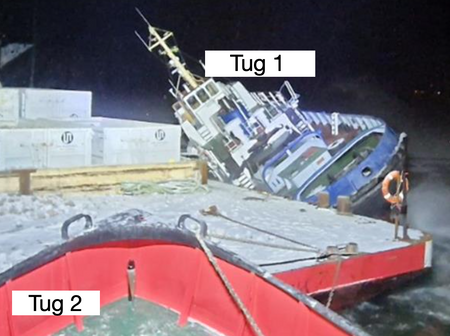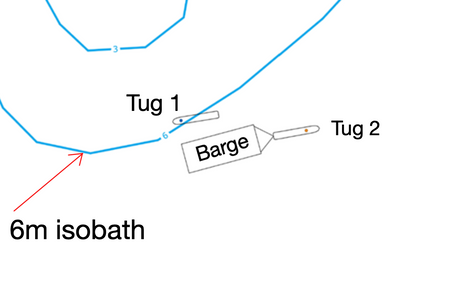202523 Loss of situational awareness leads to loss of tug
As edited from SHK (Sweden) report SHK 2025:02
Two tugs were towing a barge in coastal iceinfested waters. At one point, tug 1 had to release the tow and go around the barge to clear the ice. Tug 2 remained attached to the barge. About 10–15 metres north of their position was a shoal area of less than 6 metres in depth. When tug 1 had turned around in open water, it was observed that the open water lead was closing behind them. To free the barge, the crew of tug 1 decided to make a pass 5–10 metres from the barge’s starboard (southern) side before recoupling to the barge and continuing the tow.
As tug 1 made a full speed approach towards the barge, using the swell to break up the ice as much as possible, a last-minute decision was made to go to the port side of the barge instead (ie the north side).
Within seconds tug 1 ran hard aground at a speed of 11 knots. The grounding was violent, and the ship immediately listed heavily to port some 40 degrees. Both the master and the crewmember fell out of the wheelhouse and landed on the port bridge wing. To avoid being exposed to the cold water, the Master released the ship’s life raft.
Unfortunately, the liferaft ended up upside down on the ice and could not be used. Fearing that the vessel might capsize, the crew crossed the ice to the barge, and hence to tug 2. Tug 1 was later deemed a total loss.
The investigation subsequently found that tug 1’s ENC did not meet the standards for an approved electronic chart, and lacked information on the quality of the depth data. Additionally, the ENC’s setup made use of the same colour palette for depths between 3m and 10m. Because the tug’s draft was 4.2m, this setup gave no colour indication of the shoal danger. Another weakness in tug 1’s ENC was that it had no limit on how far it could zoom in. Electronic nautical charts that are over-zoomed can lead a user to believe that the accuracy is increased to the same extent, which is not the case.
The investigators also found that the principal navigation method was to visually follow the ice channel illuminated by the ship’s headlights and the deck lighting on the barge.


Lessons learned
- In this occurrence, the tug crew’s concentration on one task, that of breaking ice and visually following the ice channel, blinded them to the impending danger. They ran aground at full speed.
- Situational awareness is the critical factor for a navigator. It cannot be repeated enough: Use all possible means to determine your position.
- The proper use of ENCs or ECDIS is critical to sharpen your situational awareness and risk appreciation. The correct safety depth and/ or colour palette selection can make the difference in grounding your vessel, or not.
